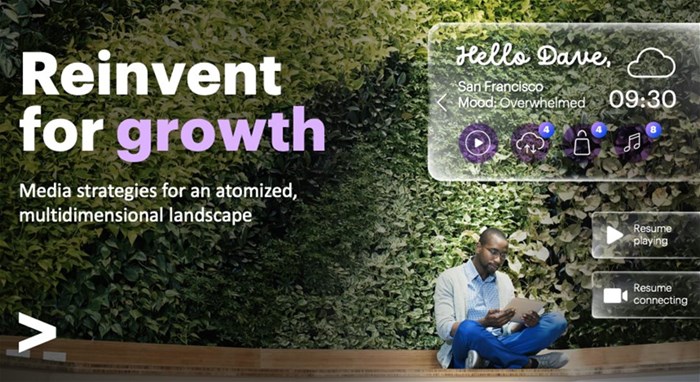Media strategies for an atomised, multidimensional landscape

The forces that have brought the industry to this critical stage of evolution are a marked shift in business models where revenue has supplanted content as the critical factor and consumer dissatisfaction with their current media experiences. Our latest research at Accenture explores how media companies can move to profitable growth by helping consumers get everything they want (and how they want it) in an increasingly atomised media landscape.
Growth slows, competition intensifies
The subscription video-on-demand (SVOD) market saw slowing growth in 2022, with fewer new sign-ups and churn rates up. 35% of consumers unsubscribed from at least one of the "Big 5" streaming video-on-demand services in the last 12 months, and 26% plan to cut one or more in the next 12 months. Tech sector players like Amazon, Apple and Google indirectly profit from entertainment by exploiting content's power to generate revenue from other sources such as e-commerce or devices.
Amazon Prime offers a range of next-generation media services, such as streaming (Prime Video), video gaming (Twitch), audiobooks (Audible), music (Amazon Music) and photos (Amazon Photos). Tech players are playing hard to win at the next level of the video value chain – streaming service aggregation. Amazon has so far acquired sports rights in key competitions and territories, and Microsoft bought Activision Blizzard for close to $70 billion in an all-cash transaction. The industry is therefore seeing a resurgence of bundles and aggregation as new entertainment ecosystems.
Their time, your money – make it simple, make it quick
Consumers are increasingly dissatisfied with the experience and expense of dealing with many different OTT services and are looking for something different. 72% of consumers now report frustration at finding something to watch, 55% are overwhelmed by the number of streaming services to choose from, and 68% want to be able to add content from other media, entertainment or streaming services to an existing subscription.
Consumers view ad-free content as a significant attraction for streaming, but 39% will decrease their spending on SVOD in the next 12 months. 52% of consumers have increased their use of entirely ad-supported videos in the past year.
Lastly, consumers are rationing their attention, with TV and movies accounting for 48% of all time spent with screen-based entertainment. Social video, gaming and fitness are all growing faster than traditional video, and over half (53%) of the consumers surveyed this year are spending more time on social video platforms like TikTok.
Emerging roles in the age of the aggregator
The shifts in consumer attitudes and preferences point to the need for aggregation, an entertainment platform that meets consumers' demands for simplicity, customisation and the right mix of varied content and services. These platforms will achieve two crucial outcomes: revenue security for media companies and logical experiences that enable consumers to find and access content quickly. Three roles will exist in the industry when these platforms emerge.
1. Audience aggregators
Audience aggregators are platform companies monetising attention and engagement through services like e-commerce, payments, and high-value devices. They create a broad audience by tying multiple entertainment services together in one place and offering product differentiation through bundling, transactional video on demand (TVOD), and various subscription flavours or advertising video on demand (SVOD/AVOD).
To succeed, these companies must excel at platform integration, customer experience, broad engagement, product development, and platform integration. Each platform must listen carefully to consumers and deliver a uniquely appropriate suite of products that satisfies the needs of their different segments.
2. Audience cultivators
Audience cultivators must focus on content/cost efficiency and find new ways to monetise their content on and off-screen. They must create efficient organisations built on digital supply chains and allocate expenses to critical endeavours to succeed. Companies must focus on lifestyle opportunities, technology platforms, marketing and sales to ensure consumer demand and ubiquity in distribution. Cultivators must build technology on cloud-based architectures and integrate with multiple audience aggregator platforms.
3. Content merchants
Content merchants need the resources of aggregators and cultivators to build and maintain standout brands. To be successful, content merchants must excel at audience insights, talent development, innovation and growth.
...and action!
The basis of competition, especially in streaming, has been evolving rapidly. Content is becoming an essential competitive resource, and all players in the media space need to build their strategies and tactics around a few critical tenets. These tenets include being value-centric and customer-centric, being hyper-attentive to other players' strategies, and constantly questioning and criticising how well their strategies deliver.
Media companies must remember that their shareholders and audiences ask a familiar question across entertainment that reflects the reality of competing for attention: "But what have you done for me lately?" Media companies need discipline and insight, and the companies with the most sophisticated understanding of their audience, their competition, and their own business will continue to rise and flourish.
About Nitesh Singh
Nitesh Singh, managing director for Communications, Media and Technology at Accenture in Africa- Essential eye-care tips and benefits15 Dec 13:31
- Switching benefit options within your medical scheme15 Dec 13:18
- Good governance is the cornerstone of sustainable healthcare04 Dec 11:00
- What medical schemes mean by 'risk stratification' - in simple terms03 Dec 16:52
- The digital future is convergence!25 Nov 15:37
































